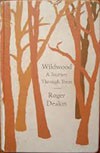



Excerpt from 'Wild Wood' by Roger Deakin
Dated Tuesday 13th November 2012

Excerpt from
Wildwood
A Journey Through Trees
By Roger Deakin
Tools And Workshops Page 381 & 379 (Hardback version)
On down to Polstead, where we meet Dylan Pym and Jude, and Dylan's workmate Carl, in their timber-framed and boarded workshop in the orchard of Maria Martin's cottage. They are working on some 'chesty' cupboards, part of a kitchen of English chestnut.
We climb a steep staircase into the upstairs office and sit around in Dylan's superb chairs of deep-brown English oak with steamed spindle backs and arms, rather in the Shaker style. 'We're totally into steaming here,' says Dylan, who is a kind of wood-working Jamie Oliver: genial, relaxed and always ready to pick up the banjo that stands in the corner and play. Dylan shows us his six-foot steaming box and the Burco boiler that powers it. 'Steaming', he says, 'is all about speed. Once it is out of the steamer, you have less than two minutes to get the hot wood strapped into its bent shape and clamped on to the form.'
We inspect the beautiful English and French hardwood seasoning in the yard outside. Dylan says trees that grow towards the light slowly spin towards it, so that for ever after they will tend to twist, even when saw them into planks, plane them, season them and store them flat. 'If their nature is to twist, that is what they will always do.'
Dylan's workshop is a boarded two-storey shed surrounded by open-fronted sheds full of seasoning timber, including the planked trunks of oaks up to three feet wide from the local woods. Inside, a blackboard on the wall is chalked up with lists of the numbered components of chairs and their dimensions and a schedule of work from day to day. Dylan's banjo rests on a windowsill, and an impressive collection of clamps is ranged along a wall. Vapour rises past them from an eight-foot plywood steam box bubbling gently, supplied by an old electric Burco boiler. I notice the dribbles of tannin staining the plywood around the steamer's ventilation holes. Dylan is making chairs of English oak. He opens the little plywood door at one end of the oblong steamer and pops in a slender six-foot length of inch-square green oak. It is going to be the curved back of a chair like a Windsor smoker's bow. Dylan explains that timing is the all-important thing in wood steaming. This particular component, he says, needs cooking for exactly twenty minutes. No more, no less. He then falls into earnest conversation with two potential clients and forgets the deadline altogether. After half an hour he remembers and opens up the box. Steam and the acrid smell of tannin billow out, and I help slide out the oak and fit it to a steel backing strap, with handles at either end, then swiftly bend it over the U-shaped form and clamp it tight. Minutes later, as soon as it has cooled, Dylan loosens the clamps and lifts off a perfect U-shaped chair back with plenty of spring in it. He hooks it up on a beam to join a row of others, destined to make a set of chairs. By using green wood from a single tree, with the same moisture content, Dylan ensures it will bend and behave consistently. He leaves the steamed components hanging up for a year to dry and season thoroughly, turns the legs on his lathe, hollows out the seats with an adze and a spokeshave, then assembles the chairs.